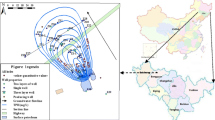Abstract
Ground water samples from several private wells serving individual homes in Tiverton, Rhode Island were analyzed for petroleum contamination over a 19-month period. The hydrocarbon concentrations initially ranged from 68 to 2350 ppb and then gradually decreased to lower values, ranging from 6 to 1650 ppb, at the end of the study.
Samples from the well with the highest hydrocarbon concentration (2350 to 1650 ppb) were investigated in some detail because this was considered a possible source of the petroleum contamination in the area. These studies indicated that most of the hydrocarbons were in the dissolved phase (<1.0 μm) of the ground water and that it contained large amounts of naphthalene, methyl and dimethyl naphthalenes, and ethyl naphthalenes. In addition, the qualitative distribution of hydrocarbons changed as the concentration decreased over the course of the investigation. There appeared to be preferential loss of the more volatile and easily degraded components relative to the higher molecular weight and more refractory hydrocarbons.
Some of the wells at this location are contaminated with at least two different petroleum products, i.e. gasoline and fuel oil. The exact nature and source of the contaminant is not known; it may be spilled or leaking petroleum products, or other materials containing petroleum hydrocarbons (e.g. commercial or industrial cleaning solutions). Based on differences in the qualitative distribution of components, some of the wells contain hydrocarbons that have been environmentally altered or that originate from a source other than the most contaminated well
Similar content being viewed by others
References
Hoffman, E.J., G.L. Mills, J.S. Latimer and J. G. Quinn, 1984. Urban runoff as a source of PAH to coastal waters.Environmental Science and Technology 18: 580–587.
Hoffman, E.J., J.S. Latimer, G.L. Mills, and J.G. Quinn, 1982. Petroleum hydrocarbons in urban runoff from a commercial land use area.Journal of Water Pollutant Contribution 54: 1517–1525.
Hurtt, A.C. and J.G. Quinn, 1979. Distribution of hydrocarbons in Narragansett Bay sediment cores.Environmental Science and Technology 13: 829–836.
Wade T.L. and J.G. Quinn, 1979. Geochemical distribution of hydrocarbons in sediments from mid-Narragansett Bay, Rhode Island.Organic Geochemistry 1: 157–167.
Pruell, R.J., and J.G. Quinn, 1985. Geochemistry of Organic Contaminants in Narragansett Bay Sediments.Estuarine Coastal and Shelf Science 21: 295–312.
Author information
Authors and Affiliations
Rights and permissions
About this article
Cite this article
Jinshu, Z., Quinn, J.G. Petroleum hydrocarbon contamination of ground water in Tiverton, Rhode Island, USA. Chin. J. Ocean. Limnol. 6, 367–375 (1988). https://doi.org/10.1007/BF02850460
Received:
Issue Date:
DOI: https://doi.org/10.1007/BF02850460




